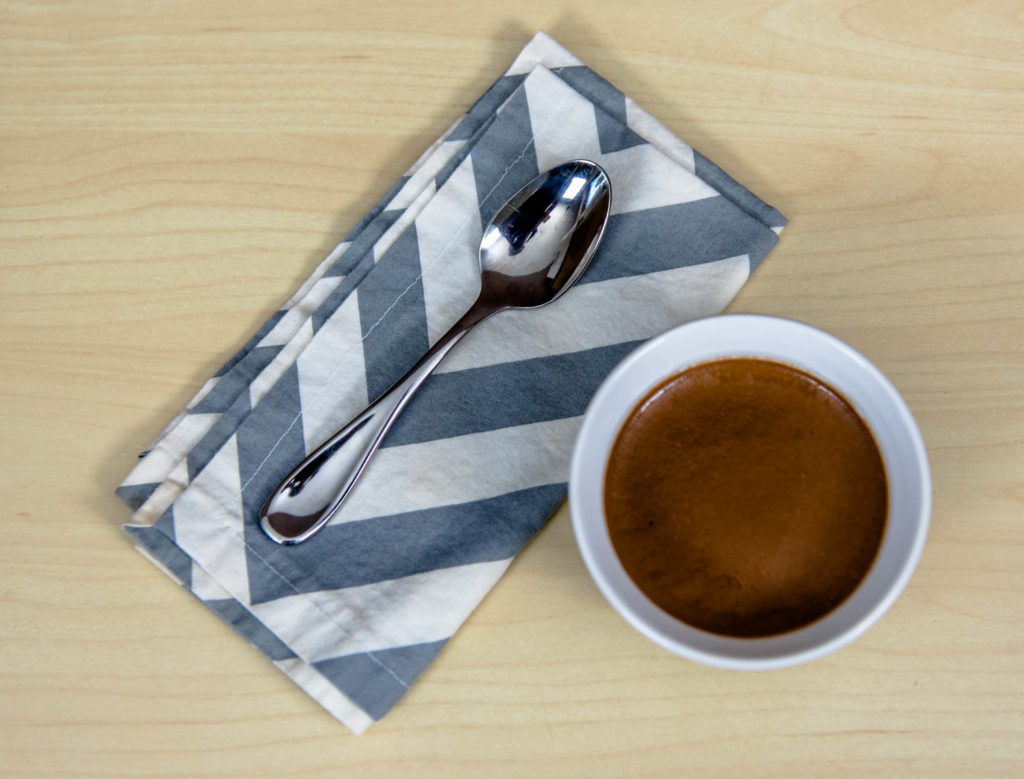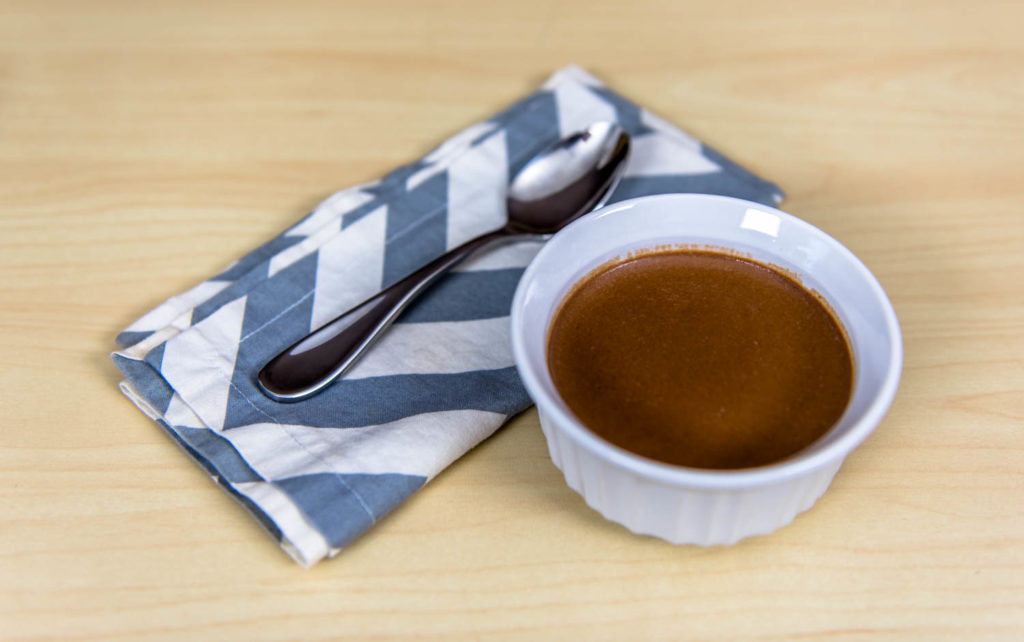CHOCOLATE PUDDING.
Is your inner child squealing with glee?
I know mine is.
I dreamed up this recipe about a month ago and it’s fast become an easy treat or snack that my husband and I enjoy regularly.
I think I need more ramekins to keep up with demand!
This pudding is perfect for someone like me who can’t handle her dairy (as much as she wants to!), but still wants something creamy and thick and a little sweet after dinner.
Want isn’t a strong enough word.
How about yearn?
I yearn for creamy, delicious desserts.
Born and raised in Iowa, I was surrounded by all the creamy goodness you could imagine. So, you can take the girl out of Iowa, but….well, you know the rest.
This pudding puts my yearnings to rest.
Now, it’s not the same as a decadently dairylicious pudding/cream/whatever other confection that can be created from the nectar of the cow.
But it harkens back enough to what I remember that I get those psychological benefits without any of the allergic drawback.
Win-win.
So let’s drill down into this tasty treat.
It’s not your average chocolate pudding.
Every ingredient is healthy and good for you.
And when combined, it’s all still pretty good for you!
I mean, we’re not talking about eating a bunch of kale here, we’re talking about pudding.
But for what it is, this chocolate treat is healthy and full of good, natural stuff for you.
It’s high fat (yes, this is good), lower sugar, with organic ingredients and no weird chemicals or stabilizers.
It’s a much better alternative than a Snickers bar or Krispy Creme donut, and it can fill that need for a little indulgence.
Indulgence does not have to be synonymous with rich, heavy food that leaves us feeling terribly sugar high or bloated afterward.
So if you’re feeling a craving creeping in, it’s a nice recipe to have on hand and whip up.
If you have some fancy serving glasses, it’s pretty enough for a party!
Chocolate Coconut Paleo Pudding
Equipment:
- 1 qt or larger saucepan; something that’s sized for you to easily pour the pudding into ramekins
- 4 4oz ramekins
- small bowl for blooming the gelatin
- measuring spoons
- whisk
- fork
- spatula
- can opener
Prep time: 2 minutes
Cook time: 3 minutes
Freeze time: 1 hour
Total time: 1 hour, 5 minutes
Here's a short video I made that shows you what you need and how to make it! It's super simple!
Ingredients:
- 1 16oz can coconut milk; I prefer this one as it minimizes stabilizers and emulsifiers, which can harm your gut lining
- 4 tbsp raw honey
- 3 tbsp unsweetened cocoa powder
- 2 tsp grass fed gelatin; I prefer Vital Proteins gelatin, as they make their sourcing very clear - only organic, grass-fed cows are used.
- 2 tbsp water
- 1/2 tsp vanilla extract
- pinch of high mineral salt
Instructions:
- Place the gelatin in a small bowl and pour the 2 tbsp. of water over it. Mix thoroughly with a fork so no lumps of gelatin remain and allow to bloom. This ensures a more even distribution of gelatin when it’s added to the other ingredients. Set aside.
- Shake the can of coconut milk until you can feel the cream and liquid begin to mix again.
- Many times the coconut cream gets separated, making it difficult to pour out. Taking a few seconds to shake the can before you open it can help you avoid a splashy mess! You might need a spatula to get all of the cream out of the can.
- Open the coconut milk with your can opener and pour into your saucepan.
- Turn the heat to medium high until the coconut milk begins to simmer for a few seconds.
- Turn off the heat and add your cocoa powder, raw honey, and pinch of salt.
- Whisk together until incorporated.
- Add your bloomed gelatin and whisk until dissolved. You do not want to boil the gelatin, but you want it to fully dissolve so the mixture needs to be warm.
- Add the vanilla extract and whisk until incorporated.
- Pour 4oz of the pudding into each ramekin and freeze for 1 hour, or refrigerate for 4 hours.
- Note: If you freeze them, you have to remember to take them out of the freezer in 1 hour. I sometimes have trouble with the gelatin setting properly if I refrigerate the pudding (it settles to the bottom), so I prefer to freeze them and remove them after 1 hour.
- Remove from freezer and store in the fridge.
- If you are serving directly from the freezer, remove them 10 minutes ahead of time in order to allow the ramekins to thaw.
- Enjoy your chocolatey coconut goodness!
Adaptations and extras:
Want MORE chocolatey goodness?
Try adding 1-2oz of melted dark chocolate like this Theo bar instead of the cocoa powder.
Your pudding consistency might change a bit with the extra liquid, so you might need to adjust the amount of gelatin.
Want to add another pop of flavor?
Try adding ginger
- Cut 2 1/4 rounds off of a root (no need to peel) and put them into the coconut milk while things are heating up. Remove before you pour the pudding into the ramekins.
- You could instead at 1/4tsp powered ginger and incorporate into the pudding
- To garnish, finely chop slivers crystallized ginger to top your pudding. Crystallized ginger is usually coated in cane sugar, so avoid this if you are avoiding or are sensitive to more refined sugars.
Try adding peppermint
- While the coconut milk is heating, take 1 stem of fresh mint, about 5in long, or 10 fresh leaves, and infuse into the coconut milk, Remove the stem or leaves before pouring the pudding into the ramekins.
- You could also substitute the vanilla extract for peppermint extract.
- Garnish your pudding with 2 mint leaves or finely chop a few almonds and mint leaves together for a minty crunch on top.
Get creative with this one and enjoy yourself!
Indulgence doesn't have to make you feel terrible.
Respect your own boundaries with foods that don't agree with you and choose indulgences that leave you feeling satisfied but not at war with yourself.
I hope this pudding adds to your recipe collection of delicious desserts!





